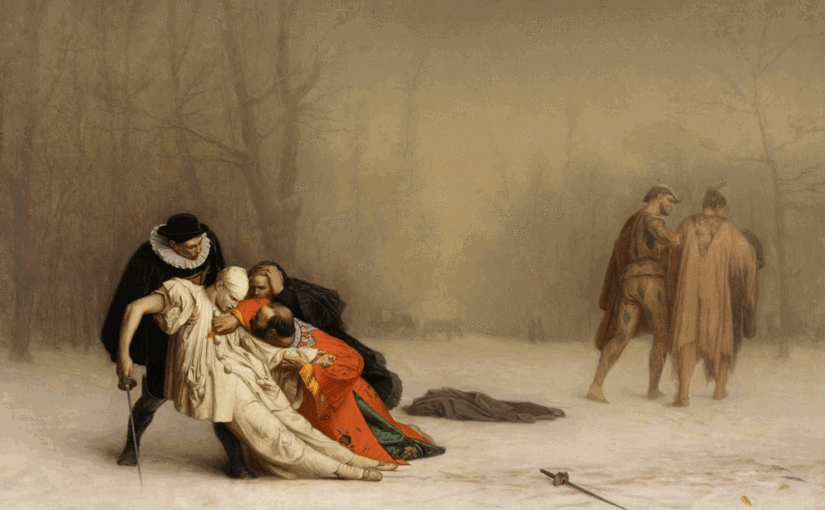Jean-Léon Gérôme is a favorite painter of mine. in his amazing life, he painted at least 351 artworks. He is considered to be a “French , Orientalist painter, draftsman and sculptor” He is awesome.
You can see all of his artwork at the Art Renewal Center here.
Pollice Verso
When I first saw this painting, I was stunned. You have to see it in it’s entirety. It is a huge canvas with a very impression spectacle.
The Latin phrase pollice verso is used in the context of gladiatorial combat for a hand gesture used by Ancient Roman crowds to pass judgment on a defeated gladiator. In modern popular culture, it is assumed that "thumbs down" was the signal that a defeated gladiator should be condemned to death. -Thumbs signal - Wikipedia
Consider the 2000 movie, Gladiator, in which Joaquin Phoenix is shown giving a defeated gladiator a thumbs down to signify that he wishes for him to be killed. According to director Ridley Scott, that scene was inspired by a painting from 1872 called “Pollice Verso“.
The painting depicts a victorious gladiator standing over the lifeless body of his opponent while a baying crowd jeers and delivers a tsunami of down-turned thumbs. Scott stated of the painting, “That image spoke to me of the Roman Empire in all its glory and wickedness. I knew right then and there I was hooked.”
That particular painting has been noted by historians as the catalyst for why the concept of pollice verso is so poorly understood today by the masses.
What makes this fact so surprising is that the painter behind the piece, Jean-Léon Gérôme, was a hugely respected historical artist who was internationally renowned for his “archaeologically correct history paintings”. Gérôme has been described as a “learned classicist” and was famous for extensively researching his pieces before putting brush to canvas.
For example, with “Pollice Verso” Gérôme studied actual pieces of armor from the ruins of Pompeii so that the gladiators in his paintings looked authentic. Gérôme’s legendary attention to detail is probably the reason that his interpretation of pollice verso was so widely accepted by academics.
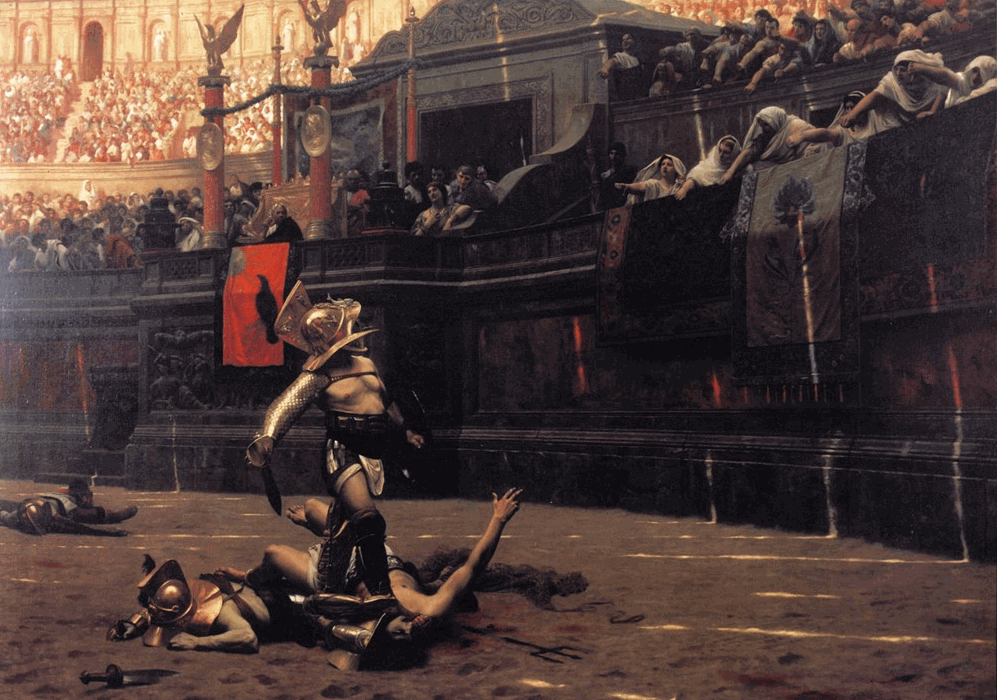
The fights between gladiators in ancient Rome were brutal. It was not like a football game (American or otherwise) where it would be assumed that both sides would go home with just a couple of bruises. Death was a fairly common occurrence at a gladiatorial game, but that doesn’t mean it was inevitable. One gladiator might be lying prone in the blood-absorbing sand of the arena, with the other gladiator holding a sword (or whichever weapon he was assigned) at his throat. Instead of simply plunging in the weapon and consigning his opponent to death, the winning gladiator would look for a signal to tell him what to do.
The Editor Was in Charge of the Gladiator Fight
The winning gladiator would get his signal—not from the crowd as illustrated in the famous 19th century painting by Jean-Léon Gérôme (1824–1904)—but rather from the referee of the game, the editor (or editor muneris), who might also be a senator, emperor or another politico.
He was the one to make the final decisions about the fates of the gladiators in the arena. However, since the games were meant to curry public favor, the editor had to pay attention to the wishes of the audience. Much of the audience attended such brutal events for the single purpose of witnessing the bravery of a gladiator in the face of death.
By the way, gladiators never said "Morituri te salutant" ("Those who are about to die salute you"). That was said once to Emperor Claudius (10 BC–54 CE) on the occasion of a staged naval battle, not gladiatorial combat.
Ways to End a Fight Between Gladiators
Gladiatorial contests were dangerous and potentially fatal, but not as often fatal as Hollywood would have us believe: Gladiators were rented from their training school (ludus) and a good gladiator was expensive to replace, so most battles did not end in death.
There were only two ways that a gladiatorial battle could be ended—either one gladiator won or it was a draw—but it was the editor who had the final say on whether the loser died on the field or went on to fight another day.
The editor had three established ways to make his decision.
- He might have established rules (lex) in advance of the game. If the fight’s sponsors wanted a fight to the death, they had to be willing to compensate the lanista (trainer)who had rented out the dead gladiator.
- He could accept the surrender of one of the gladiators. After having lost or cast aside his weapons, the losing gladiator would fall to his knees and raise his index finger (ad digitatum).
- He could listen to the audience. When a gladiator went down, cries of Habet, Hoc habet! (He’s had it!), and shouts of Mitte! (Let him go!) or Lugula! (Kill him!) could be heard.
A game that ended in death was known as a sine remissione (without dismissal).
Thumbs Up, Thumbs Down, Thumbs Sideways
But the editor didn’t necessarily listen to any of them.
In the end it was always the editor who decided whether a gladiator would die that day. Traditionally, the editor would communicate his decision by turning his thumb up, down, or sideways (pollice verso)—although modes changed as did the rules of the gladiatorial arena over the length of the Roman empire. The problem is: the confusion over exactly what thumb direction meant what is one of a longstanding debate among modern classical and philological scholars.
| Latin Phrase | Meaning |
|---|---|
| Pollices premere or presso pollice | The “pressed thumb.” The thumb and fingers are squeezed together, meaning “mercy” for a downed gladiator. |
| Pollex infestus | The “hostile thumb.” The signaler’s head is inclined to the right shoulder, their arm stretched out from the ear, and their hand extended with the hostile thumb. Scholars suggest the thumb pointed upward, but there is some debate; it meant death to the loser. |
| Pollicem vertere or pollicem convertere | “To turn the thumb.” The signaler turned his thumb towards his own throat or breast: scholars debate about whether it was pointed up or down, with most picking “up.” Death to the loser. |
| Signals from the Crowd | The audience could use the ones traditionally used by the editor, or one of these. |
| Digitis medius | Up-stretched middle finger “of scorn” for the losing gladiator. |
| Mappae | Handkerchief or napkin, waved to request mercy. |
When a Gladiator Died
Honor was crucial to the gladiatorial games and the audiences expected the loser to be valiant even in death. The honorable way to die was for the losing gladiator to grasp the thigh of the victor who would then hold the loser’s head or helmet and plunge a sword into his neck.
Gladiator matches, like much else in Roman life, were connected with Roman religion.
The gladiator component of Roman games (ludi) appears to have started at the start of the Punic Wars as part of a funeral celebration for an ex-consul. To make sure the loser wasn’t pretending to be dead, an attendant dressed as Mercury, the Roman god who led the newly dead to their afterlife, would touch the apparently-dead gladiator with his hot iron wand. Another attendant, dressed as Charon, another Roman god associated with the Underworld, would hit him with a mallet.
Diogenes
Diogenes of Sinope (c. 404-323 BCE) was a Greek Cynic philosopher best known for holding a lantern (or candle) to the faces of the citizens of Athens claiming he was searching for an honest man.
He was most likely a student of the philosopher Antisthenes (445-365 BCE) and, in the words of Plato (allegedly), was “A Socrates gone mad.”
He was driven into exile from his native city of Sinope for defacing currency (though some sources say it was his father who committed the crime and Diogenes simply followed him into exile).
Diogenes’ Beliefs
Diogenes came to Athens where he met Antisthenes who at first refused him as a student but, eventually, was worn down by his persistence and accepted him. Like Antisthenes, Diogenes believed in self-control, the importance of personal excellence in one’s behavior (in Greek, arete, usually translated as `virtue’), and the rejection of all which was considered unnecessary in life such as personal possessions and social status.
He was so ardent in his beliefs that he lived them very publicly in the market place of Athens.
He took up residence in a large wine cask (some sources claim it was an abandoned bathtub), owned nothing, and seems to have lived off the charity of others. He owned a cup which served also has a bowl for food but threw it away when he saw a boy drinking water from his hands and realized one did not even need a cup to sustain oneself.

Duel After a Masquerade
The Duel After the Masquerade is a painting by the French artist Jean-Léon Gérôme, currently housed in the Musée Condé in Chantilly, France.
Duel: a prearranged combat between two persons, fought with deadly weapons according to an accepted code of procedure, especially to settle a private quarrel.
While dueling may seem barbaric to modern men, it was a ritual that made sense in a society in which the preservation of male honor was absolutely paramount. A man’s honor was the most central aspect of his identity, and thus its reputation had to be kept untarnished by any means necessary. Duels, which were sometimes attended by hundreds of people, were a way for men to publicly prove their courage and manliness. In such a society, the courts could offer a gentleman no real justice; the matter had to be resolved with the shedding of blood.
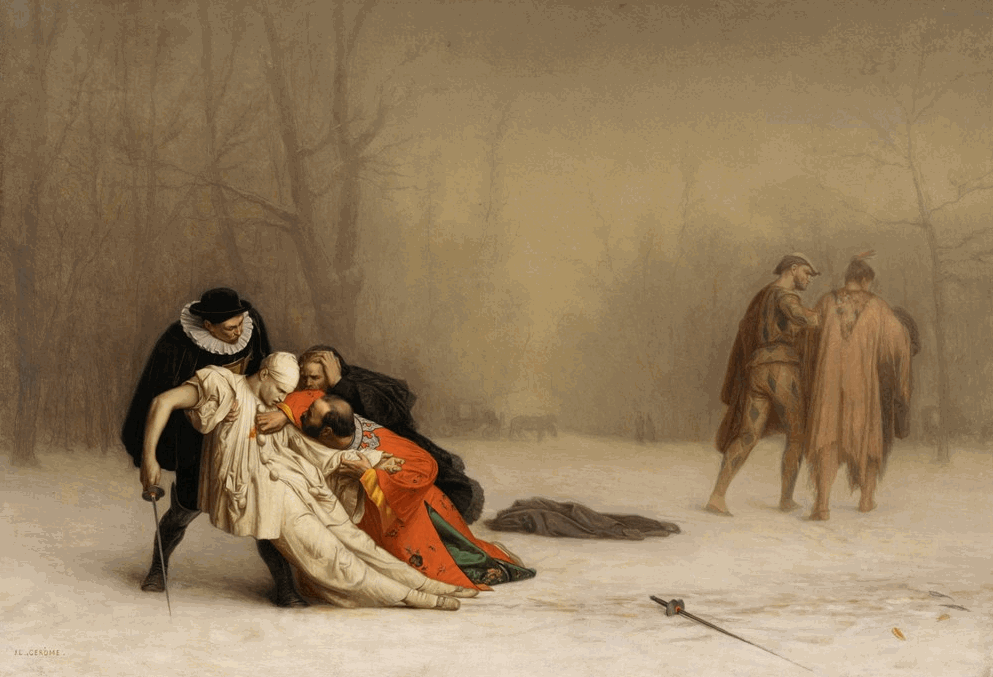
In the ancient tradition of single combat, each side would send out their “champion” as the representative of their respective armies, and the two men would fight to the death. This contest would sometimes settle the matter, or would serve only as a prelude to the ensuing battle, a sign to which side the gods favored.
“A coward, a man incapable either of defending or of revenging himself, wants one of the most essential parts of the character of a man.” -Adam Smith, The Wealth of Nations
Dueling began in ancient Europe as “trial by combat,” a form of “justice” in which two disputants battled it out; whoever lost was assumed to be the guilty party. In the Middle Ages, these contests left the judicial sphere and became spectator sports with chivalrous knights squaring off in tournaments for bragging rights and honor.
But dueling really became mainstream when two monarchs got into the act. When the treaty between France and Spain broke down in 1526, Frances I challenged Charles V to a duel. After a lot of back and forth arguing about the arrangements of the duel, their determination to go toe to toe dissipated. But the kings did succeed in making dueling all the rage across Europe. It was especially popular in France; 10,000 Frenchmen are thought to have died during a ten year period under Henry IV. The king issued an edict against the practice, and asked the nobles to submit their grievances to a tribunal of honor for redress instead.
Despite putting on a courageous front, no gentleman relished having to fight a duel and risk both killing and being killed (well, perhaps with the exception of Andrew “I fought at least 14 duels” Jackson). Thus duels were often not intended to be fights to the death, but to first blood. A duel fought with swords might end after one man simply scratched the arm of the other. In pistol duels, it was often the case that a single volley was fired, and assuming both men had survived unscathed, satisfaction was deemed to be achieved through their mutual willingness to risk death. Men sometimes aimed for their opponent’s leg or even deliberately missed, desiring only to satisfy the demands of honor. Only about 20% of duels ended in a fatality.
Duels founded on greater insults to a man’s honor, however, were often designated to go well beyond first blood. Some were carried out under the understanding that satisfaction was not gained until one man was incapacitated, while the gravest insults required a mortal blow.
The Serpent Charmer
I discovered that Bing censored this image from my sight. I guess that they felt that I couldn’t handle it, or that it would affect my notions about snakes and nudity. It’s a lovely example of Orientalist painting technique and thought.
Populating their paintings with snake charmers, veiled women, and courtesans, Orientalist artists created and disseminated fantasy portrayals of the exotic 'East' for European viewers. Although earlier examples exist, Orientalism primarily refers to Western (particularly English and French) painting, architecture and decorative arts of the 19th century that utilize scenes, settings, and motifs drawn from a range of countries including Turkey, Egypt, India, China, and Algeria. Although some artists strove for realism, many others subsumed the individual cultures and practices of these countries into a generic vision of the Orient and as historian Edward Said notes in his influential book, Orientalism (1978), "the Orient was almost a European invention...a place of romance, exotic beings, haunting memories and landscapes, remarkable experiments". Falling broadly under Academic Art, the Orientalist movement covered a range of subjects and genres from grand historical and biblical paintings to nudes and domestic interiors. -The Art Story
This painting should not be confused with his other work with the exact same name;
Here’s some great links of his art style and how they all come together…
- Three of a Kind: Jean-Léon Gérôme Works that Redefine …
- Orientalism through the Eyes of Jean-Léon Gérôme
- Four Orientalist Masterpieces by Jean-Léon Gérôme
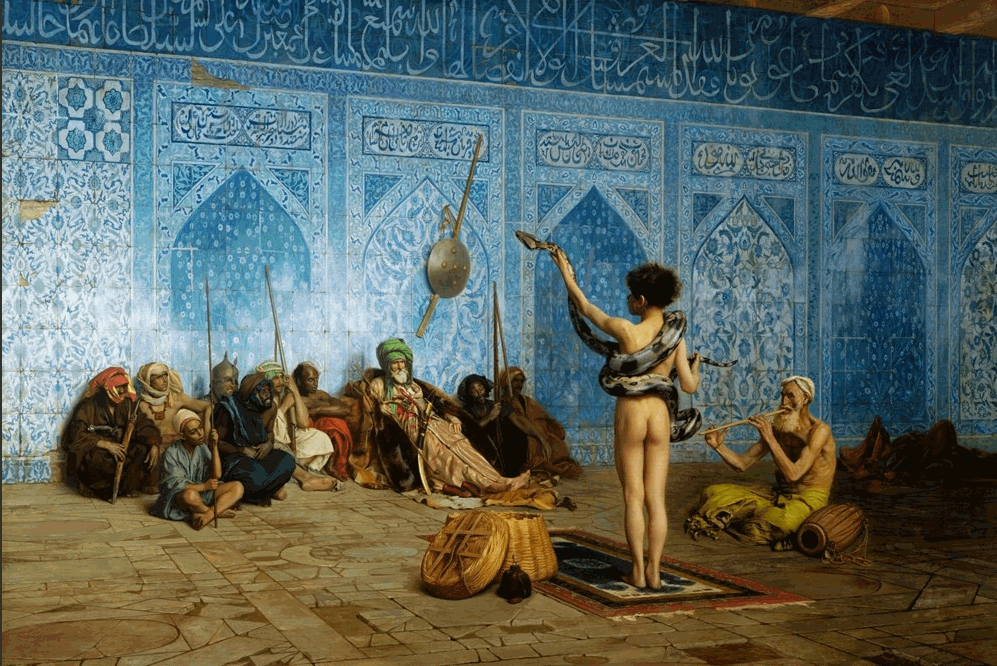
- One of the keys genres of Orientalism was the harem picture. Denied access to actual seraglios, male artists relied on hearsay and imagination to depict opulent interiors and beautiful women, many of whom were Western in appearance. The genre also allowed artists to depict erotic nudes and highly sexual narratives outside of a mythological context as their exotic location distanced the Western viewer sufficiently to make them morally permissible.
- Orientalism disseminated and reinforced a range of stereotypes associated with Eastern cultures most notably regarding a lack of ‘civilized’ behavior and perceived differences in morality, sexual practices, and character of the inhabitants. This often aligned with propaganda campaigns initiated by Britain and France as colonializing powers and images are best viewed within the context of Europe’s political and economic relationships with Eastern countries.
- Many Orientalist images are infused with rich colors, particularly oranges, golds and reds (although blue tiles are also prevalent) as well as decorative details and these operated in conjunction with the use of light and shadow to create a sense of dusty heat that Westerners would associate with the prevailing view of the Orient.
Le Combat de Coqs
The Cock Fight
Did you know from whence the English slang for penis came from? Yes, I am talking about a “cock”. Well, listen up…
The following are excerpts from the article “The Cultural Poetics of the Greek Cockfight” by Eric Csapo, in The Australian Archaeological Institute at Athens Bulletin, Vol. 4 (2006/2007) pp. 20-37.
The Cultural Poetics of the Greek Cockfight In antiquity, the cock, like the sphinx, was a liminal creature. Its habit of crowing at dawn made it a symbol of transition from night to day and darkness to light. As a marker of time and transitions, it is associated with birth, death and rebirth, and thus gains a close association with liminal deities such as Leto, Hermes, Demeter/Persephone and Asclepius. Adolescence was also closely connected to death and rebirth: Artemidorus, the dream interpreter, claims that dreams about adolescence signify marriage for the bachelor and death for the aged (1.54). [...] In myth, the cock is closely connected with the war-god, Ares. Originally the cock was a human companion of Ares named Alectryon, which is simply the Greek word for ‘cock’. At first, however, there was nothing martial about Alectryon. Before becoming a cock, Alectryon is said by Lucian to have been ‘an adolescent boy, beloved of Ares, who kept company with the god at drinking parties, caroused with him, and was his companion in lovemaking’.[1] His only soldierly duty was to keep watch while Ares made adulterous love to Aphrodite, so as to prevent the rising sun from seeing them and from reporting the affair to Aphrodite’s husband Hephaestus. Alectryon failed to keep his post even in this lightest of all soldierly duties. He fell asleep and as a result Hephaestus learned of the affair and set the trap, so memorably described in the Odyssey 8, that led to the public exhibition and humiliation of Ares and Aphrodite caught by invisible bonds in the love embrace. As punishment Ares turned Alectryon into a cock, adding, as penance, an ineluctable impulse to crow at the approach of the sun in eternal compensation for his failure to cry warning on that fateful night. [...] Cocks served as ready symbols for that supreme agon and most enduring theme of Greek art and poetry: WAR. In Aeschylus the expression ‘hearts of cocks’ stands metaphorically for the spirit of violent confrontation Eum. 861). For this reason, cocks are a favourite motif on shield blazons. Programmatic decoration on Attic vase-painting frequently draws similes between fighting cocks and mythological combatants or hoplites (see, e.g., fig. 8).[2] [...] The cock, as we noted, belongs not only to the realm of Ares, but is also close to Aphrodite. The epigrammatist Meleager took the cock on a grave stele to signal the dead man’s devotion to Aphrodite.[3] Aristotle declares that chickens are ‘most given to Aphrodite’ (HA 488b4). Oppian thinks them sex-crazed beyond all known birds.[4] This is partly justified by observation: Aristotle notes that chickens are the only animals, besides humans, whose mating habits are not seasonal or limited. Indeed they are less limited than humans. [...] Given the cock’s association with both sex and masculinity, it is not surprising that it was the preferred love gift given by mature men to beautiful youths (fig. 13).[5] In Margaret Visser’s words ‘the cock expressed the sheer maleness of the couple, their virile aggressivity and energy’.[6] [...] In most parts of the world cockfighting is a sport practised exclusively by adult males, but in Greece the sport was ideally represented as a pastime for adolescent boys, and particularly young aristocrats. We have seen that in Greek art the human figures associated with fighting cocks are boys, and mostly adolescent boys. Language also encouraged a close identification between the adolescent and the cock. Cocks were, like their owners, ‘aristocrats’; fighting cocks were termed ‘noble’, those unfit for sport ‘ignoble’ or ‘vulgar’.[7] The harsh sounds made by an adolescent whose voice is breaking are referred to as crowing, kokkusmos (gallulare in Latin).[8] And while words for ‘cock’ and ‘penis’ are homonymous in the vernacular of a great many languages, the Greek equivalent, koko, is only ever used as a ‘pet name’ for the puerile member.[9] The close almost exclusive identification of fighting cocks with élite adolescents is hard to square with a tale about martial valour, an express concern of all Greek males. Rather, it reflects the particular configuration of male homosexuality in Classical Greece with its emphasis on pederasty and its predominantly aristocratic milieu.
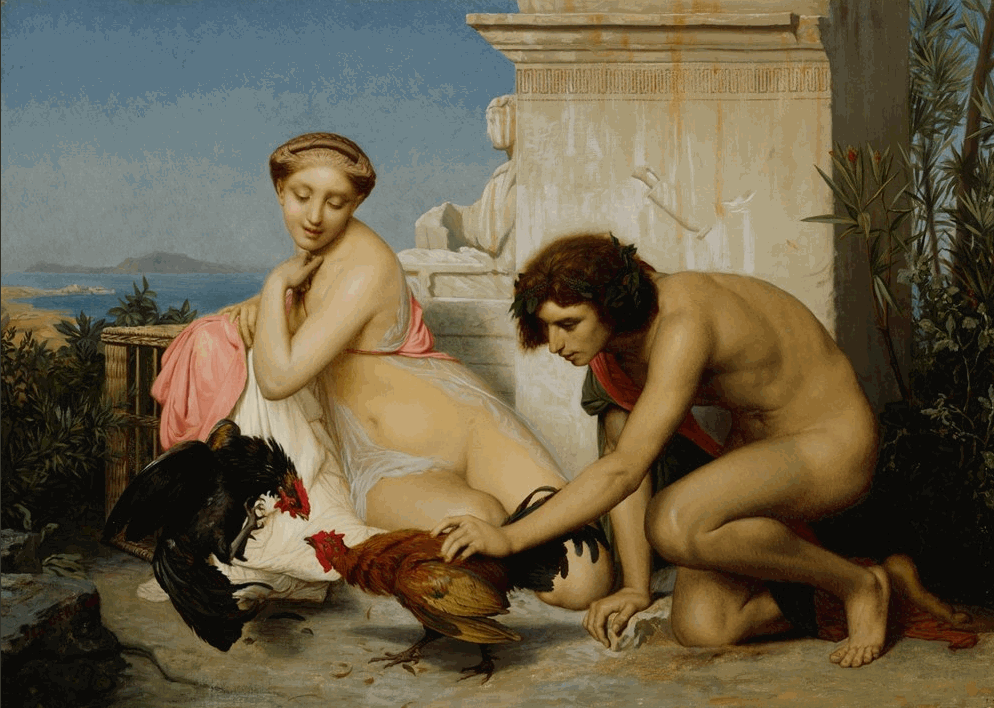
Pygmalion and Galatea
Pygmalion Classical Mythology. a sculptor and king of Cyprus who carved an ivory statue of a maiden and fell in love with it. It was brought to life, in response to his prayer, by Aphrodite.
The story of Pygmalion and Galatea is quite known and popular till, well… nowadays.
Pygmalion, a famous sculptor, falls in love with his own creation and wishes to give this creation life. This simple and imaginary concept is actually the basis from a psychological understanding of male behavior and wish. This nice myth is considered as the depiction of the masculine need to rule over a certain woman and to inanimate his ideas into a female living creature.
Galatea n. Greek Mythology A maiden who was originally a statue carved by Pygmalion and who was brought to life by Aphrodite in answer to the sculptor's pleas.
The strange sculptor
Pygmalion was a sculptor par excellence, a man who gave to every one of his ivory a life-like appearance. His deep devotion to his art spared him no time to admire the beauty of women.
His sculptures were the only beauty he knew.
For reasons known only to him, Pygmalion despised and shunned women, finding solace only in his craft. In fact, he was so condemning to women that he had vowed never to marry.
Falling in love with his own creation
One fine day, Pygmalion carved the statue of a woman of unparalleled beauty. She looked so gentle and divine that he could not take his eyes off the statue. Enchanted with his own creation, he felt waves of joy and desire sweeping over his body and in a moment of inspiration he named the figurine, Galatea, meaning “she who is white like milk”.
He draped over her the finest of cloths and bedecked her with the most dazzling of ornaments, adorned her hair with the prettiest of flowers, gave to her the choicest of gifts and kissed her as a sign of adoration.
Pygmalion was obsessed and madly in love with his creation.
The spell the lifeless woman cast on him was too much to resist and he desired her for his wife. Countless were the nights and days he spent staring upon his creation.
The realization of his dream
In the meantime, the celebration of goddess Aphrodite was fast approaching and preparations were well under way.
On the day of the festival, while making offerings to goddess Aphrodite, Pygmalion prayed with all his heart and soul, beseeching the goddess that she turns his ivory figurine into a real woman.
Touched by his deep veneration, Aphrodite went to the workshop of Pygmalion to see this famous statue by herself. When he looked upon the statue of Galatea, she got amazed by its beauty and liveliness.
Looking better at it, Aphrodite found that Galatea looked like her in beauty and perfection, so, satisfied, she granted Pygmalion his wish.
Upon returning home the master-sculptor went straight to Galatea, full of hope. At first, he noticed a flush on the cheeks of the ivory figurine but slowly it dawned upon him that Aphrodite had heard his pleas.
Unable to restrain himself, he held Galatea in his arms and kept her strongly. What had been cold ivory turned soft and warm and Pygmalion stood back in amazement as his beloved figurine came into life, smiling at him and speaking words of admiration for her creator.
Their love blossomed over the days and before long, wedding vows were exchanged between the two lovers with Aphrodite blessing them with happiness and prosperity.
The happy couple had a son.
His name was Paphos, and he later founded the city of Paphos in Cyprus. Some say that Pygmalion and Galatea also had a daughter, Metharme.
The bottom line is that the couple lived happily ever after.
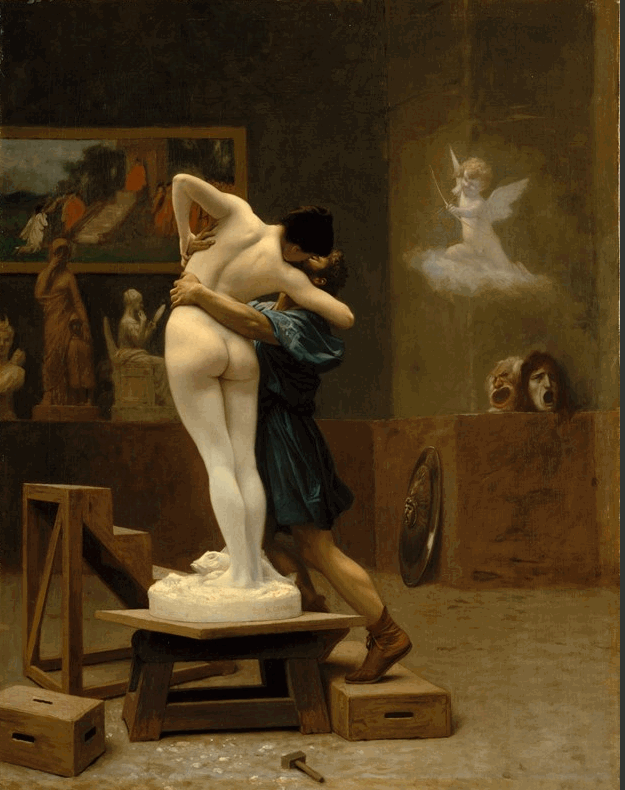
Black Bashi-Bazouk
Bashi-bazouk, Turkish Başibozuk, (“corrupted head,” or “leaderless”), mercenary soldier belonging to the skirmishing or irregular troops of the Ottoman Empire, notorious for their indiscipline, plundering, and brutality. Originally describing the homeless beggars who reached Istanbul from the provinces of the Ottoman Empire, the term bashi-bazouk was later applied to all Muslim subjects who were not members of the armed forces. Finally it was applied to units of irregular volunteers (both infantry and cavalry) attached to the army but under independent officers and providing their own weapons and horses. These forces became notorious for their lawlessness. They appeared at the end of the 18th century and fought in Egypt against Napoleon. During the Crimean War the allied generals made fruitless attempts to discipline them. Their excesses during the Russo-Turkish War of 1877–78 at last forced the Ottoman government to abandon their use. -Bashi-bazouk | Ottoman soldier | Britannica
This arresting picture was made after Gérôme returned to Paris from a twelve-week journey to the Near East in early 1868.
He was at the height of his career when he dressed a model in his studio with textiles he had acquired during the expedition.
The artist’s Turkish title for this picture—which translates as “headless”—evokes the unpaid irregular soldiers who fought ferociously for plunder under Ottoman leadership, although it is difficult to imagine this man charging into battle wearing such an exquisite silk tunic.
Gérôme’s virtuosic treatment of textures provides a sumptuous counterpoint to the figure’s dignified bearing.
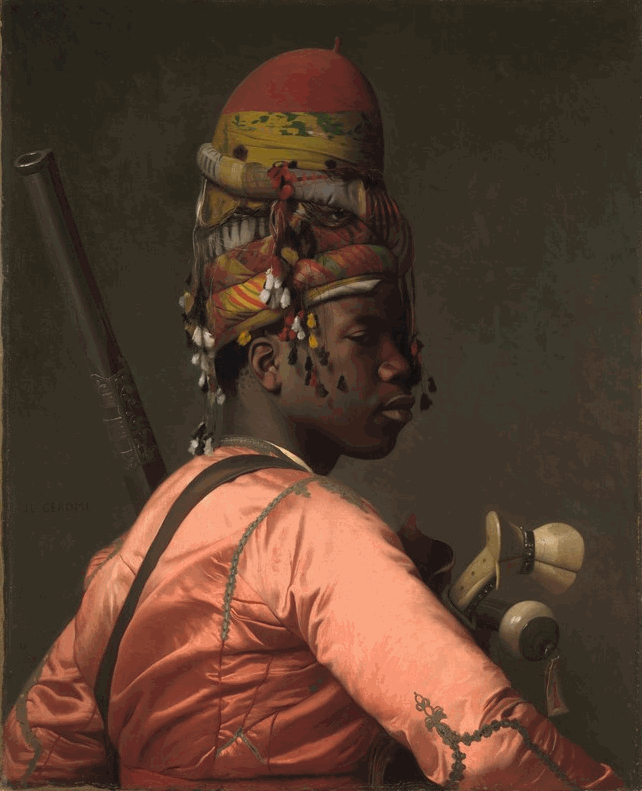
The Slave Market
Orientalism is, in a nutshell, “the way that the West perceives of — and thereby defines — the East”.
Imagine you are a 13th or 14th century European. The Silk Road has just recently established contact and trade with a distant land; a land so far away and so difficult to reach that it exists only in the imagination of the average European.
Earlier accounts of this land have been passed down by the Greeks from centuries ago, telling of an alien world inhabited by “dog-faced creatures”, or Phasians so yellow it was as if they “suffered from jaundice” (summarized by Gary Okihiro in “When and Where I Enter”).
Centuries after that, Egeria’s 4th century text Peregrinatio ad terram sanctam describes an exotic, fantastic Asia that “served to highlight the positive, the real, the substantial Europe”.
These tales are not just stories; for the West, they become synonymous with “what Asia is”.
In recounting Marco Polo’s travels, one historian wrote…
“[Polo’s] picture of the East is the picture which we all make in our minds when we repeat to ourselves those two strange words ‘the East’ and give ourselves up to the image which that symbol evokes”.
Thus, almost from the moment of first contact, the West established a unique and specific relationship with the East — one that still impacts and influences our conceptions of these regions today.
In this relationship (as defined by Edward Said), the West is the “Occident”: the norm, the standard, the center, the fixed point around which the rest of the world orbits.
The East is, by contrast, the “Orient”: the abnormal, the exotic, the foreign, the Other defined specifically by its deviancy from the Occidental, Western norm.
Importantly, this relationship — what Said terms “Orientalism” — draws upon exaggerations of both Occidental and Oriental traits in order to create an Orientalist fantasy that is a fictional recapitulation of both East and West.
Western men are re-imagined as universally Godly, good, moral, virile, and powerful — but ultimately innately human.
By contrast, those traits that best serve as a counter-point to the Occidental West are emphasized in the West’s imagined construct of the East: strange religions and martial arts, bright colors and barbaric practices, unusual foods and incomprehensible languages, mysticism and magic, ninjas and kung fu.
Asia becomes innately unusual, alien, and beastly.
In Orientalism, Asia is not defined by what Asia is; rather, Asia becomes an “Otherized” fiction of everything the West is not, and one that primarily serves to reinforce the West’s own moral conception of itself.
It is also important to note that Orientalism historically arose both from an attempt to “honor” Eastern cultures as well as to redefine them for the West.
Orientalism purports to be a faithful recreation of Eastern traditions and peoples, but actually draws upon real practices and traditions to create an Eastern construct that is largely exaggeration and myth.
Which leads us to this display of slaves in front of a store…
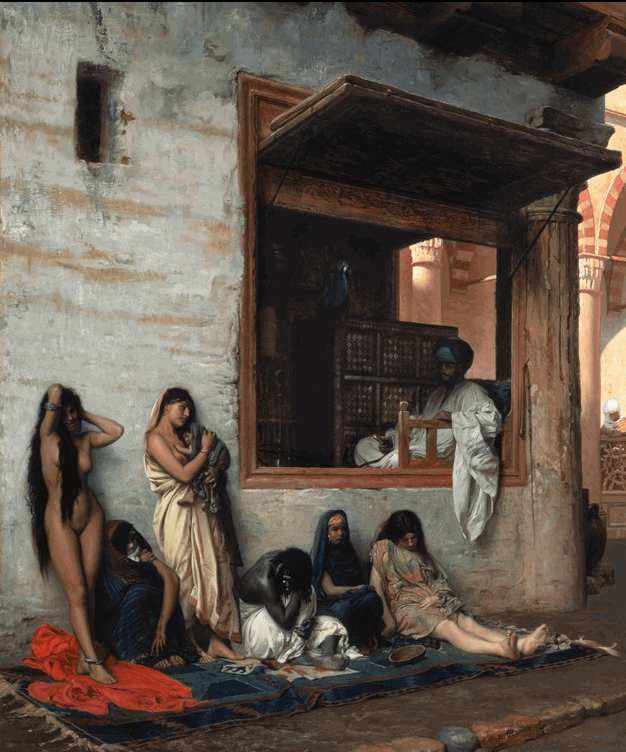
Ave Caesar, Morituri te Salutant
Hail Caesar, We Who Are About to Die Salute You!
This is another painting that depicted the gladiatorial battles and events of ancient Rome. I have read that this saying “we who are about to die salute you” was not all that common, and perhaps only occurred once. But who really knows? Eh?
It’s a nice painting, done in magnificent style.
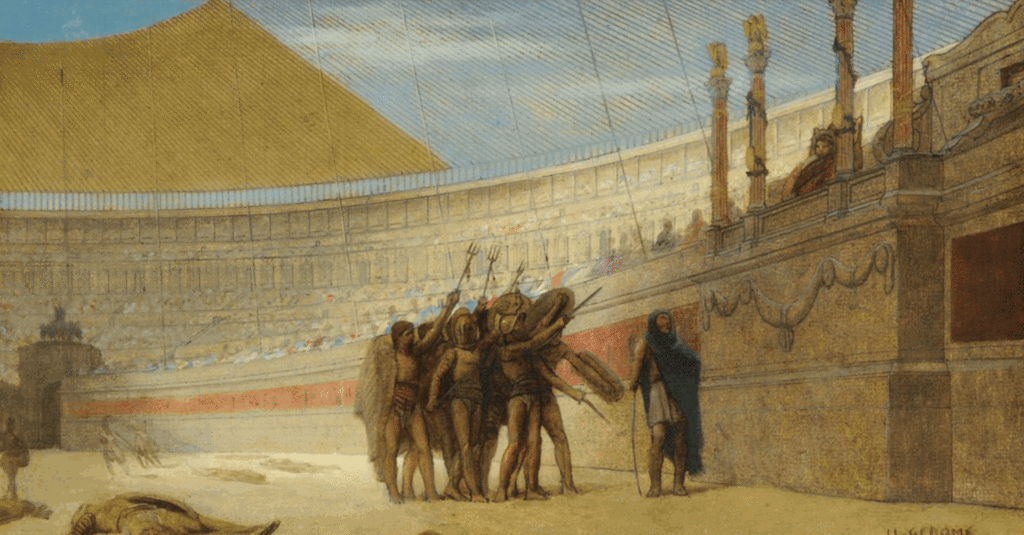
Le Barde Noir
The Black Bard
Usually artists that paint Caucasian peoples have a difficult time painting other races. Not so in this painting. The colors and the skin tones are all right on and correct. This is a lovely painting and would be particularly impressive over a fireplace in a Victorian home.
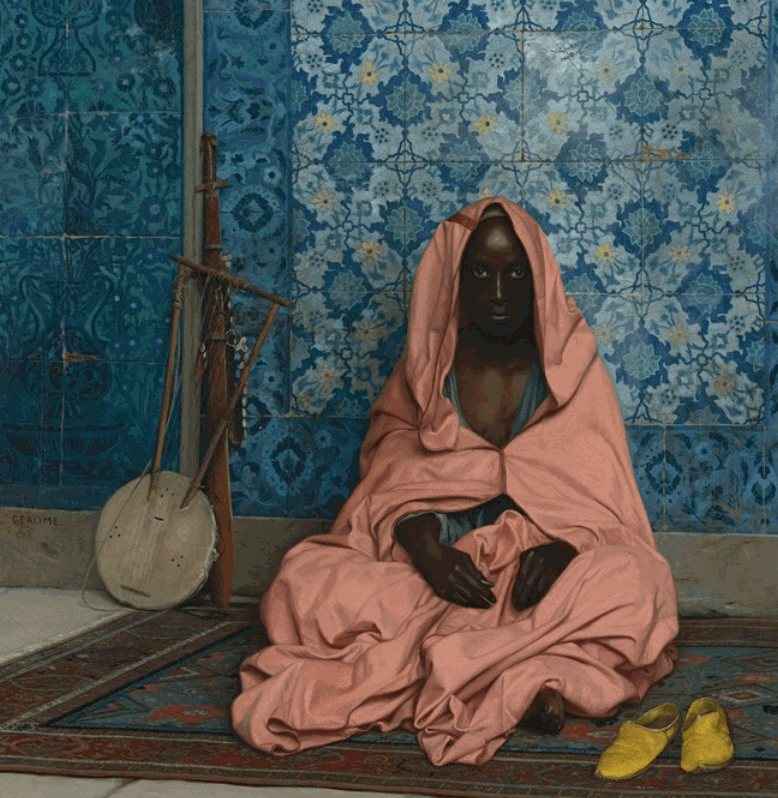
Le Tigre et le Gardien
The Tiger and the Guardian
Another fine work. I love how hot it appears outside and how cool the inside of the building appears.
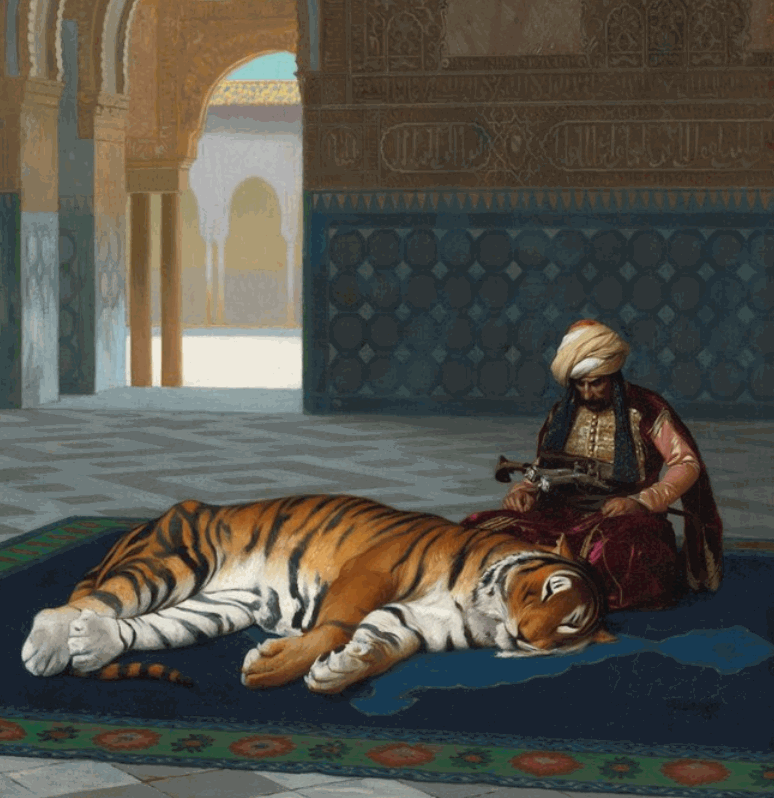
Harem Women Feeding Pigeons in a Courtyard
A fine example of his work. No explanation is required.
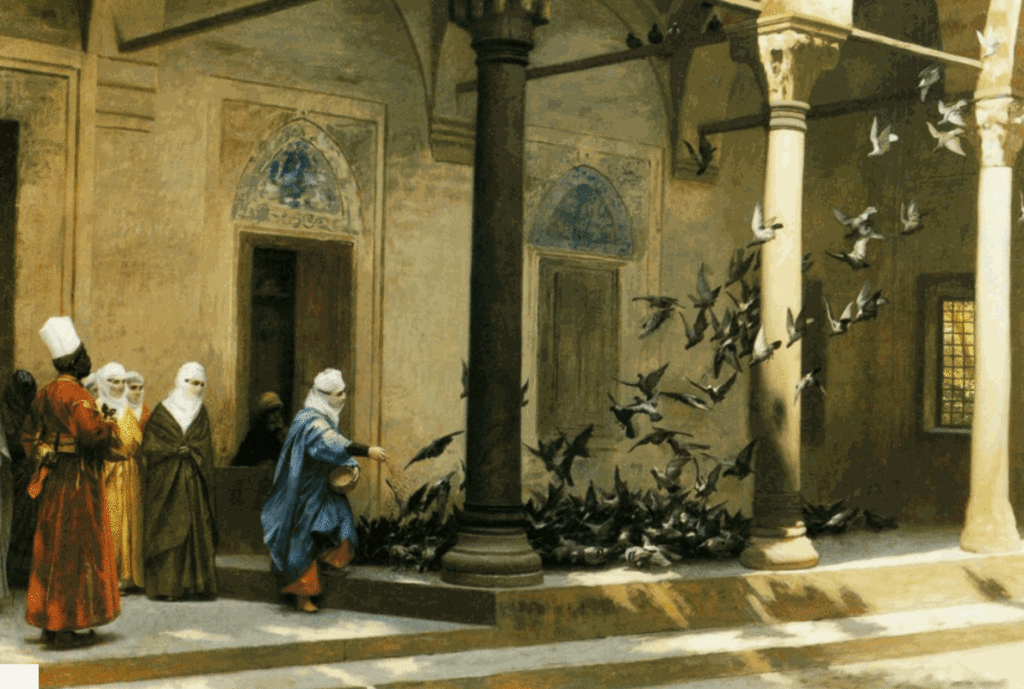
The Negro Master of the Hounds
This is a nicely done painting, with great “atmosphere” and a particularly excellent rendering of the dogs. Most figurative painters have spent decades working on their technique and skills with the human body. As a result, when they paint animals, the skill level is often incomplete. While horse and dogs are sometimes rendered perfectly, for the most part, cats and other creatures tend to suffer artistically.
No so in this painting.
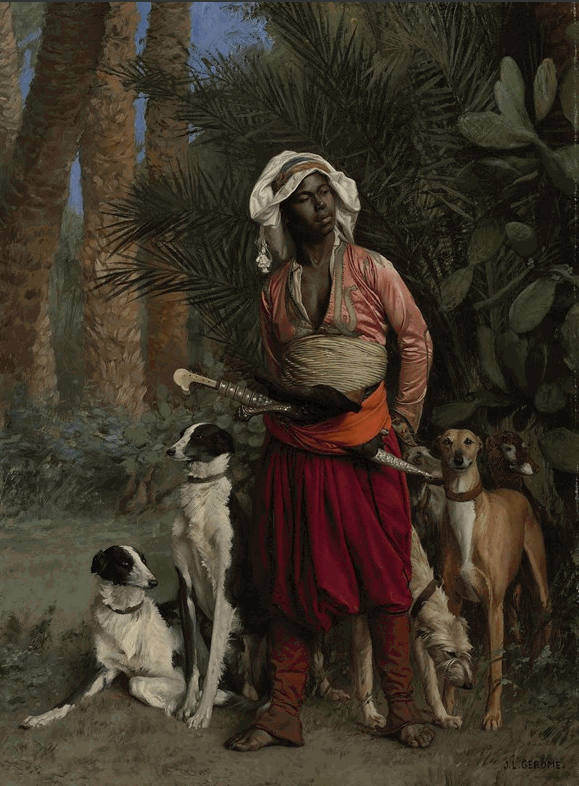
Napoleon and His General Staff
In ordering an expedition to Egypt and creating an Army of the Orient in April 1798, under the command of the young General Bonaparte, France’s post-revolutionary Directory sought to do two things.
- The first was to block Britain’s trade route to India and re-establish commerce with the Levant.
- The second unstated objective was to remove the ambitious young Bonaparte, whose popularity following his success in the Italian Campaign of the previous year rendered him a threat in current volatile politics.
General Bonaparte famously addressed his troops on their arrival in Egypt with the words …
“From the heights of the Pyramids, forty centuries look down on us”.
The reality of France’s Egyptian Campaign was less grandiose, and descriptions by surviving French Officers of Napoleon’s decision to trek his 37,000 troops across the desert rather than follow the Nile River from Alexandria, tell of appalling mismanagement, of thirst, discomfort, disease and death.
Nevertheless it was in the Battle of the Pyramids (more accurately the Battle of Embabeh in the Gaza plain where the battle actually took place) that Napoleon famously routed the Mameluke cavalry by putting into practice his innovative use of the massive so-called ‘divisional square’, a tactic first deployed in Antiquity.
The Mamelukes had effectively ruled Egypt since the thirteenth century and were legendary, apparently invincible, and fearless warriors. Their defeat at the hands of General Bonaparte further enhanced his reputation.
The Battle of the Pyramids, between French troops led by Bonaparte and 21,000 Egyptian Mameluke soldiers was a resounding victory for the French.
In contrast, the French naval fleet, stationed in the Bay of Aboukir, was attacked by the newly arrived British fleet, under the command of Horatio Nelson, and was roundly defeated.
Following this naval defeat, Bonaparte’s Egyptian campaign remained land-based.

Having installed himself as master of Egypt by force, Bonaparte then set about installing in Egypt what he viewed as the benefits of western civilization. He established the Institut d’Egypte for French scholars, a library, a chemistry laboratory, a health service, a botanical garden, an observatory, an antiquities museum and a zoo.
Diane et Acteon
According to a Greek myth, Actaeon, the son of Aristaeus and Autonoe, surprises Diana, the Greek Artemis, while she was bathing with her nymphs. As a punishment she turned him into a stag and, no longer recognized by his pack of 50 hounds, she was torn to pieces by them.
Greek myths were not very accepting of voyeurism, I guess.
What I find interesting is that the myth takes place in ancient Greece, and that the women are bathing in the pool together, while suddenly a troop belonging to an English Fox Hunt comes barrelling in from the top of a Hill. This juxtaposition of different times and cultures is curious to say the least.
In Victorian painting, and Orientalism, the use of Greek and Roman histories and myths to elaborate upon “modern” life was all the rage. And, as I might add, helps sell the works to a hungry audience.
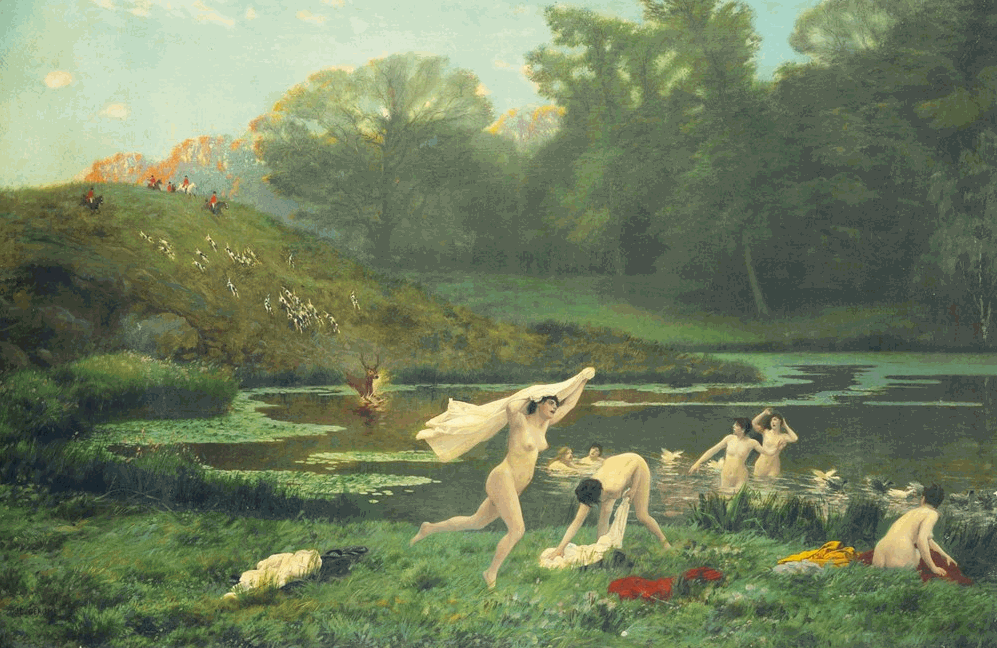
Harem Pool
Orientalism had a great deal of interesting subject matter to paint. Slaves, mercenaries, hot deserts, magnificent ruins, blue skies, steamy hot sands, and harems. Here is one such painting that depicts a harem and a bath pool.
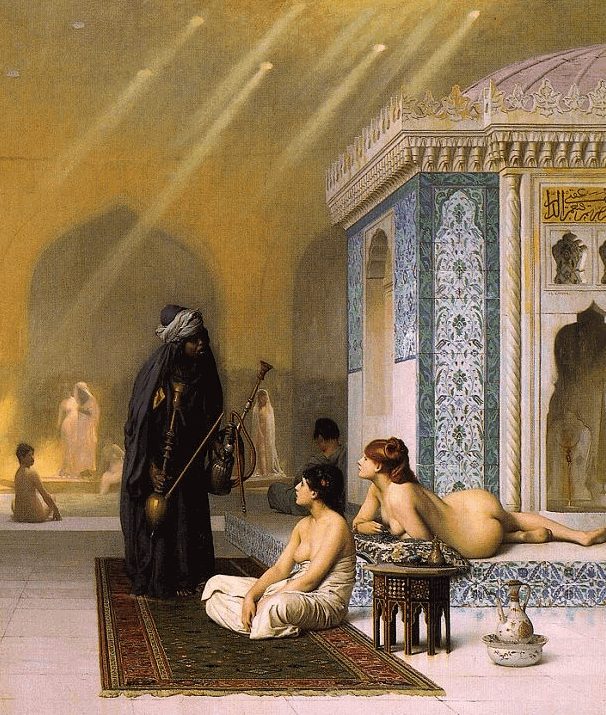
I love so many things about this particular painting.
- Look at the detail on the carpet!
- Study the artwork of the blue tiles.
- The drapery and clothing of the woman in blue.
- The two nudes in the forefront.
- The folds of the towel of the woman up front and how her hand lightly touches her leg.
Slave Auction
A slave being auctioned off in Rome.
This painting, and the next one after it are different views of the same scene. The auctioneer and the maiden being sold are in both paintings, but the view of each are different. The only thing that is different is the building in the background. The first is a brick circular structure with a corbelled ceiling, the second is a traditional Roman pillared motif.
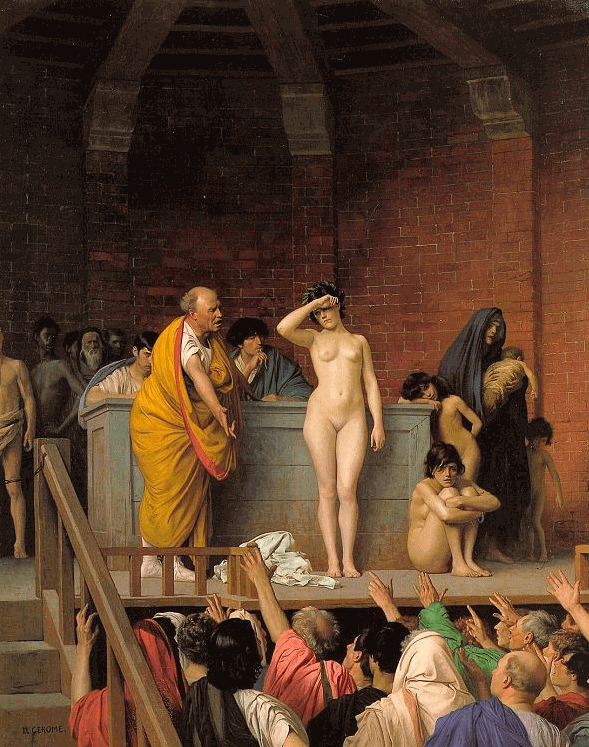
Roman Slave Market
Slave markets were a big thing with Orientalism. Most non-artists would argue that this is because all Victorian men and artists were demented sexual perverts that beheld secret fantasies. This is really nonsensical. There are really three reasons why this was a great subject for Victorian Orientalism paintings.
- You were able to paint a female body on display in all it’s nuanced form.
- The subject matter makes for a great story, and has significant history behind it.
- Paintings that depicted slavery in any form were a prized commodity and sold quickly.
Here we have a picture of slave being sold to the highest bidder in Rome…

King Candaules
Imagine you are the queen of Lydia.
It is late and you are about to disrobe before your king in the privacy of his royal bedchamber. The monarch is reposing on a sumptuous bed that is perfumed with myrrh, aloes, and cinnamon.
His eyes keep fixated on you as you move toward a chair situated near the doorway of the room. You stand motionless for a time, as is your custom, soaking in your exquisite surroundings through the flickering candlelight.
He clutches giddily at a plush cushion with trembling hands.
It is time.
You pull the ivory pin fastening your hair, shake out your dark-brown curls, and proceed to slip out from your finely embroidered robe and place it on the chair.

In captivating fashion you let drop your undergarments one after another around you. There you stand before your adoring husband with your youthful form revealed in all its beauty.
But just then, all of a sudden, a strange sense of being watched creeps over you.
You cast a furtive glance toward the doorway, instantly recognizing the voyeur peering back at you from the shadows. The interloper gasps. A panicky utterance from the king cannot mask the ensuing patter of feet followed by an awful clatter down the stairs.
As a succession of muted groans reverberate into the night, you are faced with the infuriating realization that the king was behind the entire plot.
In the awkward silence that follows you [1] confront the king, [2] cover yourself and scream for the royal guards, or [3] say it was probably just the cat and handle it in the morning.
…
If your name is Queen Nyssia, the voyeur is Gyges, and Candaules is king, then you will choose option [3] and handle it in the morning.
This at any rate is the story as it is related by Herodotus. That is apart from Gyges toppling headlong down the royal staircase, which is an elaboration on the series of events of my own invention.
Herodotus, in any case, writes in some detail on Candaules’ efforts to persuade Gyges to view his wife:
This Candaules, then, fell in love with his own wife, so much so that he believed her to be by far the most beautiful woman in the world; ...and believing this, he praised her beauty beyond measure to Gyges son of Dascylus, who was his favorite among his bodyguard; ...for it was to Gyges that he entrusted all his most important secrets. After a little while, Candaules, doomed to misfortune, spoke to Gyges thus: “Gyges, I do not think that you believe what I say about the beauty of my wife; men trust their ears less than their eyes: so you must see her naked.”
Gyges made every attempt to turn down Candaules’ request, but in the end the king’s will prevailed, and he consented to the proposal.
Nyssia, having surmised all of this, sent for Gyges at dawn the next morning and presented him with a choice:
- Either commit suicide at once as retribution for his transgression.
- Murder Candaules and usurp the throne with her as his wife.
Gyges pleaded with Nyssia to reconsider, but he soon found this to be a hopeless cause, and reluctantly agreed to kill his master. They murdered Candaules in his bed on the very next night.
After being named king, Gyges legitimised his hold on power, which was still precarious, by securing a favourable declaration from a Delphic oracle.
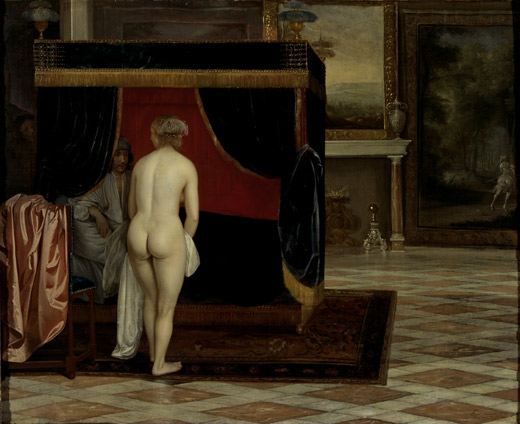
The oracle coupled a confirmation of Gyges’ right to rule over the Lydians with a prophesy that Candaules’ family – the Heraclids – would take revenge on the usurper in the fifth generation.
The prophecy proved true, but by that time Gyges was dead.
In recognition of the oracular endorsement, Gyges had a hoard of gold and silver sent to the shrine at Delphi.
The delivery included, we are told, six golden mixing-bowls that weighed nearly 800kg when taken all together.
Gyges reigned for a total of 38 years (from 716 BC to 678 BC according to tradition) and was succeeded by his son Ardys II. No further details on the life of Nyssia are recorded.
This is the Herodotean narrative of Gyges’ rise to power.
Modern scholarly opinion has Herodotus drawing on dramatic rather than historical sources, and it has been speculated that his story is based on a tragedy in five acts with three actors and a chorus.
Heads of the Rebel Beys at the Mosque of El Hasanein, Cairo
Bey, Turkish Bey, Old Turkish Beg, Arabic Bay, or Bey, title among Turkish peoples traditionally given to rulers of small tribal groups, to members of ruling families, and to important officials. Under the Ottoman Empire a bey was the governor of a province, distinguished by his own flag (sancak, liwa). In Tunis after 1705 the title become hereditary for the country’s sovereign. Later “bey” became a general title of respect in Turkish and Arab countries, added after a personal name and equivalent to “esquire” (or “sir” in conversation) in English. In the 20th-century Turkish republic, bey, though surviving in polite conversation, was replaced by bay before the name (equivalent to “Mr.”). -Bey | Turkish title | Britannica
I would imagine that this is the display of the chopped off heads of rebels in Egypt. Little else is known about this work. Certainly one can let their imagination run wild and contemplate a group of rebels that want to wrest control of the government from the egyptian leadership..
And that is one of the beautiful things about Orientalism. You look at the beautiful images of far-away and distant lands and contemplate what the story might be behind those images…
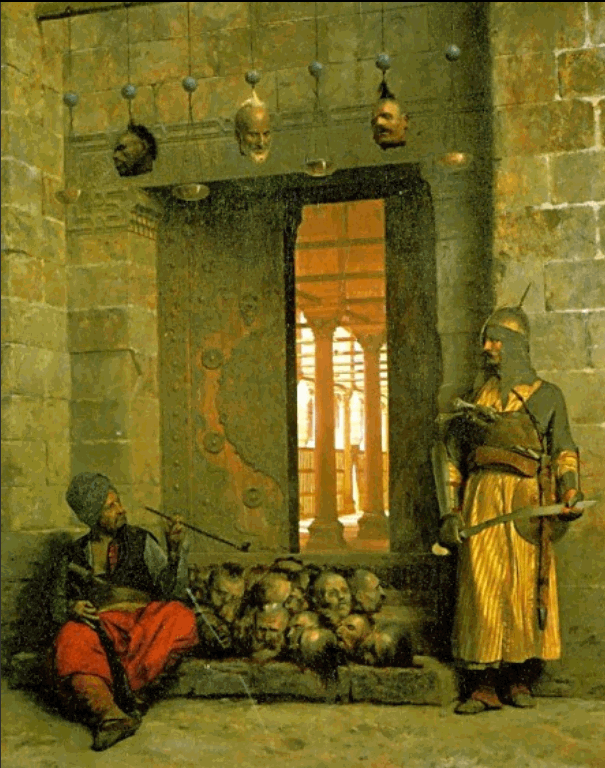
Slave Market
Then as today, much of the Arab world engages in slave trading. Here we see an image that was sure to shock the Victorian sensibilities of Europe. Shocking; where a Caucasian woman is displayed as a slave for purchase.
Recently I found myself at the Clark Art Institute in Massachusetts, standing in front of an orientalist image. Together with a colleague I was looking at The Slave Market by Jean-Léon Gérôme, painted in 1866, only one year after the official abolition of slavery in the US. The caption of the painting said the following: A young woman has been stripped by a slave trader and presented to a group of fully clothed men for examination. A prospective buyer probes her teeth. This disturbing scene is set in a courtyard market intended to suggest the Near East. The vague, distant location allowed nineteenth-century French viewers to censure the practice of slavery, which was outlawed in Europe, while enjoying a look at the female body. My colleague repeated the words in a whisper: indeed, highly disturbing. I couldn’t respond, unsure whether I was really disturbed by the painting or rather by the official institutional rendering of my emotions. I had no courage to stand there longer and dwell on the scenery of the slave market, because the atmosphere created by the museum’s visitors seemed to force me away from what was supposed to be disturbing. -e-flux
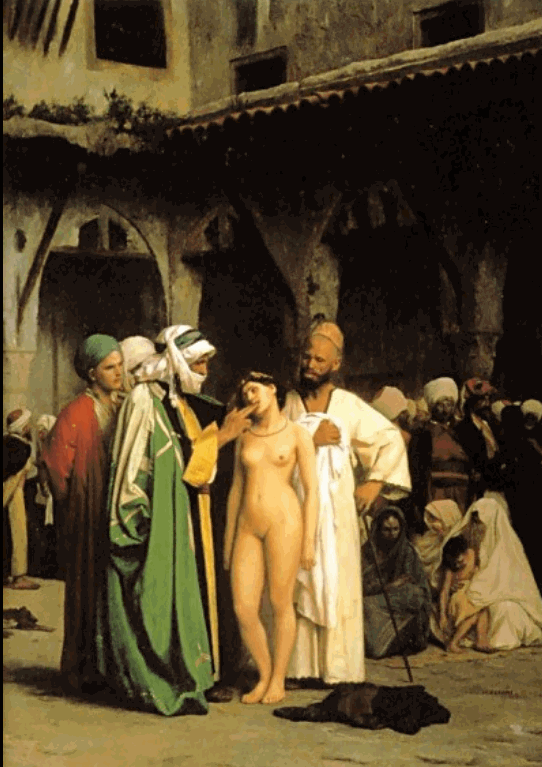
Un Bain Maure Femme Turque au Bain, No.2
A Moorish Bath – Turkish Woman Bathing, No.2
I love this painting. It’s got mood, and “environment”. You can imagine a steamy bath with dim shadows, and piercing rays of incredibly bright sunlight piercing through the gloom.
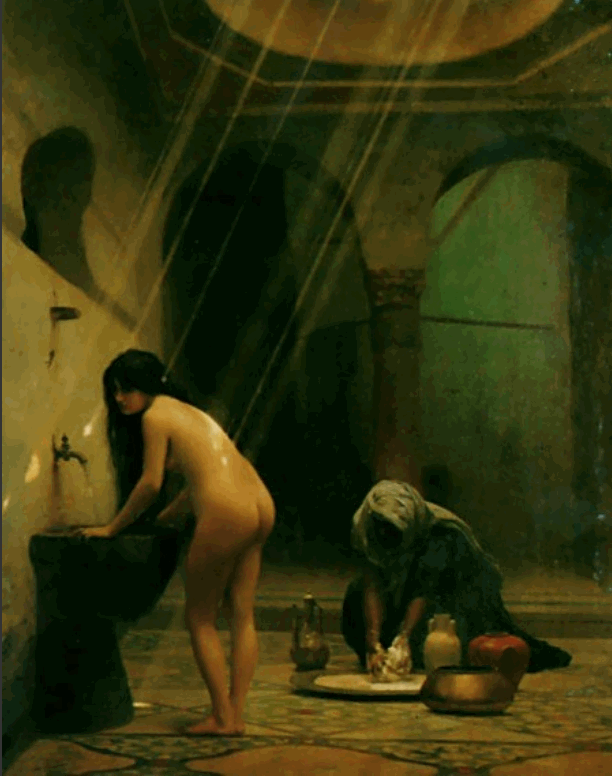
Qui que tu sois, voici ton maitre
Whoever you are, here is your master
It looks to me that cupid has control over all animals of the world. I see lions, tigers and other cats… perhaps an panther. But nothing else. I wonder if this is a statement about love, or a statement about cats… It’s hard to tell which.
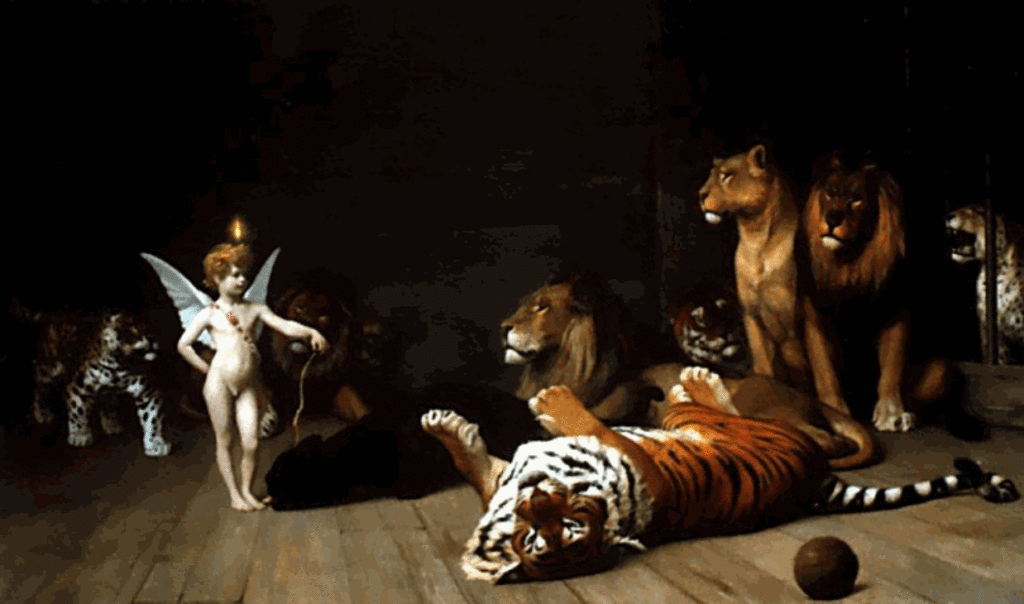
The Terrace of the Seraglio
I like to believe that Gerome was unaware of adding romanticism in his works. However, the classical rigorously composition, strong oriental flavor and exotic atmosphere made people feel his romantic trend.
In 1856 Gerome went to Egypt and the Near East and developed his keen interest in the oriental culture. Therefore he painted many works depicting the local customs of Egyptian and Near Eastern societies. After the exhibition at the Paris salon, his works created a great sensation.
In 1868, he followed the geologists through the Sinai desert and arrived in port Alexander in Cairo. Regardless of this very dangerous journey, the oriental culture gave the painter a very deep impression. The Arabia market, Turkey bathroom and bath of maids, Islamic religious ceremonies, and the chambers with the mysterious colors seemed to be mysterious, interesting, beautiful and amazing.
The Terrace of the Seraglio made by Gerome depicted the most secret imperial life of the Arabia palace. And this painting also portrayed the lives of the princesses and the maids.
Some were in the bath, some were chatting, and some were meditating…almost all showed a melancholy and vacant look.
The beautiful terrace was as cold as a cell suffering the oppression. Only the outside gazebo had the clear sky and the fresh air. Both the composition and color processing were left with the classical principle of preciseness, harmonious contrast and attention to detail, characters, clothing and building which were especially important to the performance of the texture and the exotic sense.

Do you want more?
I have more posts in my Art Index here…
ARTArticles & Links
You’ll not find any big banners or popups here talking about cookies and privacy notices. There are no ads on this site (aside from the hosting ads – a necessary evil). Functionally and fundamentally, I just don’t make money off of this blog. It is NOT monetized. Finally, I don’t track you because I just don’t care to.
To go to the MAIN Index;
Master Index.
- You can start reading the articles by going HERE.
- You can visit the Index Page HERE to explore by article subject.
- You can also ask the author some questions. You can go HERE .
- You can find out more about the author HERE.
- If you have concerns or complaints, you can go HERE.
- If you want to make a donation, you can go HERE.
Please kindly help me out in this effort. There is a lot of effort that goes into this disclosure. I could use all the financial support that anyone could provide. Thank you very much.
[wp_paypal_payment]

